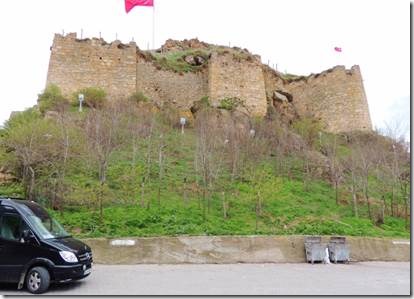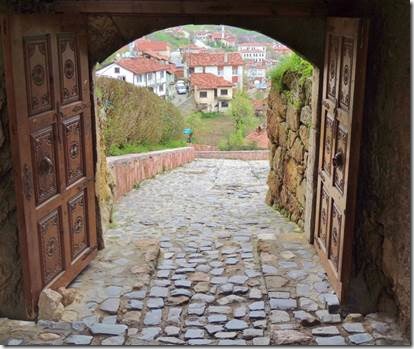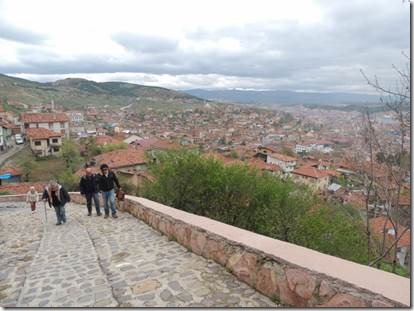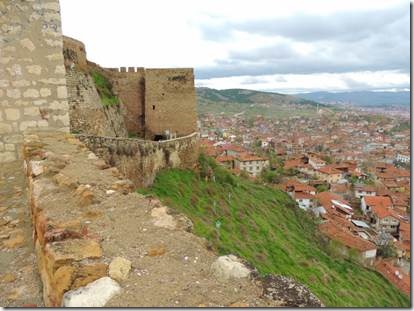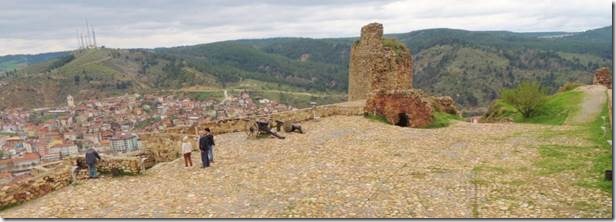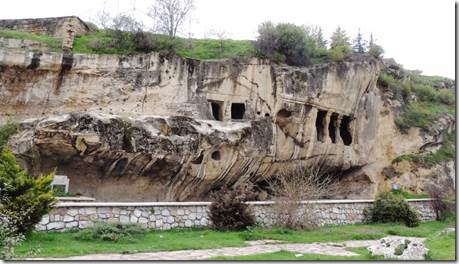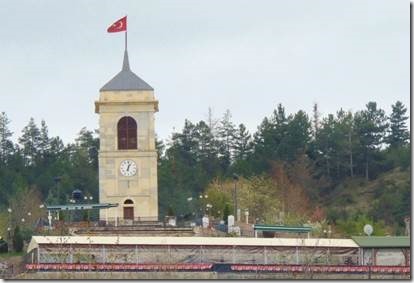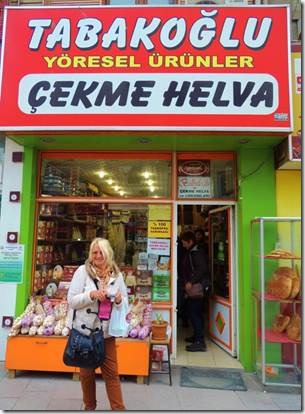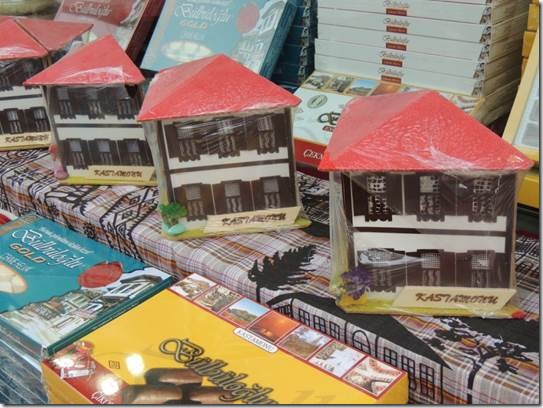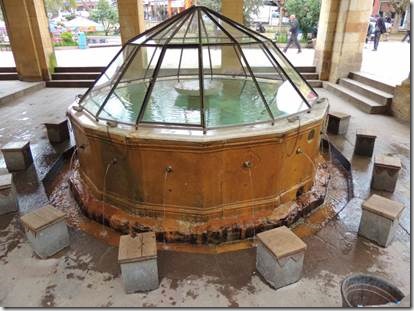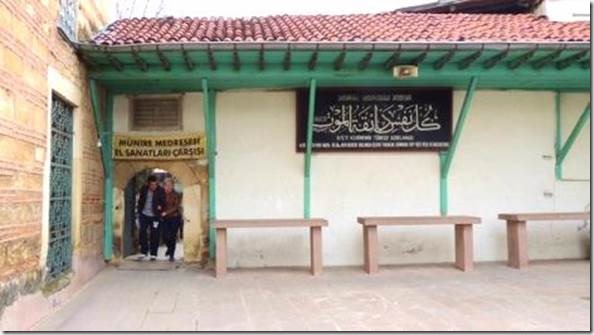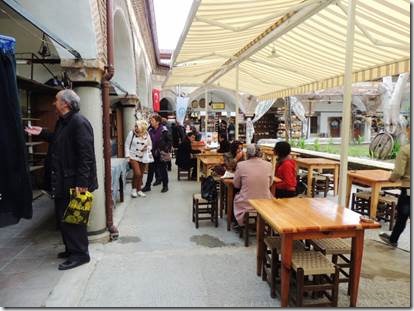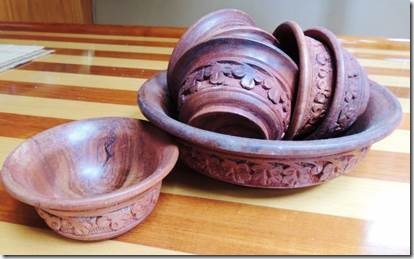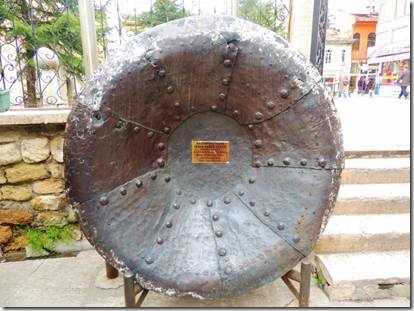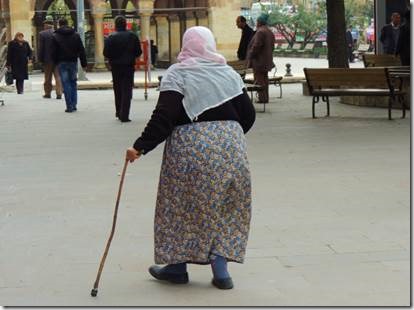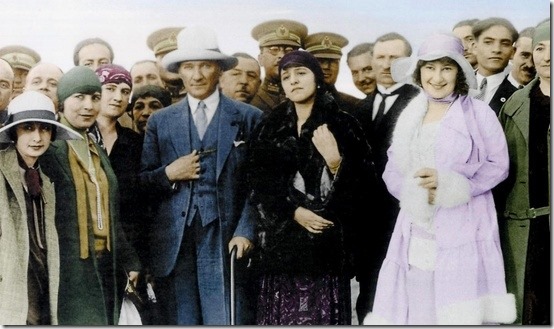Merhaba,
This was going to be a quick email; we spent less than 2 hours in Kastamonu, so how much can you write? But as I read, I had questions, so then I read more and had more questions. It was a long day’s drive from Sinop to Safranbolu. We made three stops along the way; two for seeing and one for eating, One could spend several days in Kastamonu. But as we had things to do and places to be, we only had time for a quick stop. If you ever go, plan to spend longer and make sure you try the helva.
Ru
The neglected charms of Kastamonu
“Why oh why don’t more visitors make it to Kastamonu? Of course, I know the answer to that question really — there’s no sea, no sand and not much nightlife to speak of either. Still, for the sort of people who like a dollop of history to go with their holiday, then this Central Anatolian stronghold is, surely, the perfect destination boasting an attractive setting, a dramatic castle, lots of mosques, hans and hamams dating back to the Middle Ages and several Ottoman-style hotels that could on their own almost justify the bus ride.” http://www.todayszaman.com
|
“Let’s start with the castle. Kastamonu sits in a valley between two steep hills, which means that the best vantage point from which to view the castle is from the hill on the opposite side where a tiered tea garden fronts a clock tower dating back to 1885. Sitting here you will be able to appreciate how neatly the castle hugs the contours of the other hill. The existing building is not as ancient as some of Anatolia’s real oldies, having started life as a Byzantine work of the 12th century. Everyone has heard of the Byzantines, but the dynasty who went on to rebuild the castle, the Candaroğlus, is more of a mystery. In 1292 their first significant leader, Temür Yaman Candar, took advantage of the chaos that followed the collapse of the Selçuk Empire to establish his own dynasty (beylik) around Kastamonu. Not surprisingly he liked the look of the old castle and had it refortified. Candar’s descendants dominated the area immediately north of Ankara and west along the Black Sea to Bolu right through 1462 when, inevitably, Sultan Mehmet the Conqueror came galloping through to establish Ottoman control. In the last few years restoration work has made the castle a focal point for the burgeoning domestic tourism industry, which means that visitors must run a gauntlet of tablecloth-selling shopkeepers on the steep path leading up to it. Disappointingly, there’s not that much to see inside — although you do get a great view of the clock tower.” |
|
Sad Legend of the Clock Tower Behind the Governorship building high above the Sarayüstü Hill rests an important focal point of the city, the Clock Tower. It was built in 1885 while Abdurrahman Pasha vas the governor of Kastamonu. There is a legend surround this tower that this clock once was in Istanbul. In the late 1800s its bell made such a loud noise that the sultan princess who was living near it at the time got scared and resulted a miscarriage of her baby. Therefore as punishment to the clock it was sent to Kastamonu far away from Istanbul. However, never minding the legend, the tea you will sip in its gardens will provide you the best view of Kastamonu. http://www.pbase.com/osmantanidik/kastamonu_clock_tower |
|
This is our friend Patricia posing outside the Tabaksons’ locally made helva ( halva) shop. On a whim I bought a box of the helva and it was the best stuff. Randal thought it was dry, but I thought it just melted in your mouth reminiscent of really good cotton candy. Looking for info about Çekme Helva I found other comments comparing it to cotton candy. I also read that Turks had to learn about “sweets” from other cultures, many introduced from the Middle East. Kastamonu producing traditional palace dish ANKARA – Turkish Daily News | 7/27/2005 12:00:00 AM | The traditional ‘palace halva’ of Kastamonu, historically made by specially trained cooks in Seljuk and Ottoman palaces for centuries, is now being reproduced for residents of and visitors to Kastamonu, reported the Anatolia news agency. The traditional “palace halva” of Kastamonu, historically made by specially trained cooks in Seljuk and Ottoman palaces for centuries, is now being reproduced for residents of and visitors to Kastamonu, reported the Anatolia news agency. Nearly 10 tons of palace halva are produced daily, and Turkish Airlines serves this special dessert to its foreign guests on their flights. In fact, many tourists have visited Kastamonu after enjoying this tasty treat on a plane. The Bülbül brothers, Hayri and Erdem, specialize in palace halva and serve their products in stores located in Istanbul, İzmir, Ankara, Bursa and Antalya. They say foreign tourists like this traditional concoction as much as Turks. Hayri says it is quite difficult to make real palace halva, adding that it takes five specially trained cooks. He said the cooks pray before preparing the dessert. Bülbül said halva ingredients consist of plain flour, sugar, quality butter and water, and requires much manual pulling and kneading of the mixture. It is customarily served on Muslim holy days and at weddings, circumcision parties and funerals. |
|
The next door actually did sell Bülbül brothers Helva I took this photo to show the helva sold in boxes made to look like Ottoman houses. But I noticed the lettering on the yellow box and the name Bülbül. |
|
Before praying, one must wash. It was cold but those who went to pray had stopped to wash. There are many times, before beginning to pray that Jews are also supposed to wash their hands. It’s interesting to me to see so many customs that I think of as Jewish that are common among countries of the Middle East. |
|
Entrance to the small bazaar/tea garden |
|
Too chilly to sit and have tea and too many shops to hunt for a “treasure.” |
|
Randal couldn’t resist this set of wooden bowls which were turned on a lathe and hand carved. |
|
The bath’s boiler of a Dervish Lodge is what the sign near it said. I’m guessing it was to heat water for the hamam (bath.) |
|
I’m always attracted to the little cute ladies, and this one sent me on a tangent looking into services to the elderly in Turkey. I gave her a few TL. Later we saw her again Taṣ, good-hearted person that he is, collected some money for her from our group. I have no idea how old she was; harder lives make people look older. But it did make me wonder how hard the life is for elder women in Turkey where once, like most societies, families cared for elderly or infirm members. I came across the following document published in 2007: The Situation of Elderly People in Turkey and National Plan of Action on Ageing “However, in Turkey, the number of people benefiting from social security programs who are insured in the literal sense has not reached the adequate level and a comprehensive social security network could not be built as of yet. ……. Entitlement of the elderly person to some kind of an income becomes important in terms of economic sustainability of his or her living. Survey results indicate that 56 per cent of the elderly population is entitled for some kind of income. On the other hand, there are significant differences between male and female elderly population in terms of being entitled to income. While 75 per cent of men are entitled for an income, the percentage drops down to 38 per cent for women. Looking at the analyses on the source of income, 46 per cent of elderly men cited their pension, while other sources cited were old-age pension and rental/interest income. Only 10 per cent of elderly men work. While only 6 per cent of elderly women are entitled for pension of their own, percentage of women who cited indirect pension as their source of income was 16 per cent. 10 per cent of elderly women are entitled for old-age pension and only 1 per cent still work. The state offers its services to elderly people through accepting them to the nursing homes it opens and looking after them until they die. The private sector, on the other hand, offers its services through opening nursing homes or sending care providers to those who live by themselves or with their families. Especially in rural areas, someone from the family cares for the elderly individual unofficially. This person is usually the spouse, daughter, daughter-in-law, niece or granddaughter of the elderly individual, which means that most of the time women assume the responsibility for caring for elderly people. Women who in particular have concerns about ageing and believe that they would not be able to care for themselves when they get old consider staying in homes planned specially for elderly people more positively compared to men who count on their wives in this respect.” The Situation of Elderly People in Turkey and National Plan of Action on Ageing |
|
Ataturk’s Hat Ataturk encouraged the Turks to wear modern European attire. . After most civil servants had adopted the western hat with their own free will, in 1925 Mustafa Kemal wore his "Panama hat" during a public appearance in Kastamonu, one of the most conservative towns in Anatolia, to demonstrate that the hat was the headgear of civilized nations. |
|
The following article about the Polish Jew who made Ataturk’s Kastamonu hat especially caught my attention because my mother’s father was a cap maker and his father made caps for the Czar’s special guard…or so family lore has it. |
|
Granddaughter recalls the Polish Jew who designed Atatürk’s hats ISTANBUL – Hürriyet Daily News | 5/18/2011 12:00:00 AM | VERCİHAN ZİFLİOĞLU Polish Jew Adolf Loker was the designer of the revolutionary hats of Mustafa Kemal Atatürk, founder of the Turkish Republic. Documents and photos about Atatürk that Loker was keeping in his safe were destroyed during the Sept 6-7, 1955 events. Loker’s granddaughter Mari Loker-Gormezano, a deputy candidate from the Republican People’s Party, or CHP, says: ‘I grew up as an admirer of Atatürk; this is not a thing that was imposed’ The switch from the fez to Western-style hats was one of the most visible changes brought by the foundation of the Turkish Republic after the destruction of the Ottoman Empire. As for the architect of this “dress code revolution,” Mustafa Kemal Atatürk, he had his hats designed by Adolf Loker, a Polish Jew from a long line of hat makers. The best known of these hats was the one Atatürk wore during his visit to the Black Sea city of Kastamonu in 1925 – a hat that today is on display at the former assembly building in Ankara, according to Loker’s granddaughter, Mari Loker-Gormezano. A deputy candidate for the Republican People’s Party, or CHP, in the upcoming elections, Loker-Gormezano spoke to the Hürriyet Daily News about her grandfather’s relation with Atatürk, the story of her family and her own political adventure. In addition to Adolf Loker, all the family members admired Atatürk, Loker-Gormezano said, adding that her grandfather was very sad when the founder of the Turkish Republic died. “He [Adolf] was keeping all documents and photos about Atatürk. But the safe in his hat store in Istanbul’s Karaköy district was destroyed during the Sept. 6-7, 1955, [events] with all the materials in the store,” she said. “Newspaper clippings and the hat at the former assembly building are the only things that remain from the friendship between Atatürk and Loker.” The events of September 1955, among the painful in Turkey’s recent history, occurred when daily Istanbul Express published news that the house where Atatürk was born in Thessalonica had been bombed. The response to this saw the houses and business places of many Greeks, Armenians and Jews destroyed. Loker-Gormezano defined these unhappy events as temporary. “It is necessary to understand the sincerity and feeling of the Anatolian people. They react against anything rapidly but calm down,” she said. “Those who know about this feature of Anatolian people make use of it. The future concerns me, not the past.” The closeness of the Loker family, which moved to Istanbul 600 years ago, to Atatürk is not only limited to his relationship with the hat maker. According to Loker-Gormezano, her older aunt İlda Berkoviç was the future Turkish leader’s French teacher. “I grew up with admiration for Atatürk, it was not a thing imposed later,” she said, adding that she has now become a candidate for the CHP, a party founded by Atatürk. “I follow in the footsteps of my grandfather,” she said. ] Rejected as TRT presenter Loker-Gormezano said she had applied to the Turkish Radio and Television Corporation, or TRT, to become a presenter, but this dream of hers did not come true, something she claimed was because of her Jewish background. “Yes, I could not become a presenter but I did not give up. Now I am a deputy candidate [for Parliament]. If I am wanted, I will become successful,” she said. If she is successful in entering Parliament after the June 12 general elections, Loker-Gormezano will become the second Jewish deputy in Turkey’s recent history after Cefi Kamhi, an Istanbul deputy from the True Path Party, or DYP, in 1995. “I believe that people are born and live equally. My views will not change if I enter Parliament or not,” she said. “People should not be discriminated against because of ethnic identities. Unfortunately, the word ‘minority’ is highlighted all the time but we are all citizens of the Turkish Republic. That’s why all citizens should have the same rights. I am for human rights and equality.” http://www.hurriyetdailynews.com/ Fashion history was made in Kastamonu; Men’s headwear : Turban to Fez to Western style hats. These days when it comes to the argument over modernity the focus may be all on women and the headscarf, but once upon a time the tables were turned in the other direction, and it was what men wore on their heads that drew all the attention. Even in the 19th century the sultans found time to worry about what their male subjects were wearing, and it was the reformer Mahmut II (1803-39) who decreed that they should drop the turban in favor of the fez, the cylindrical, maroon-colored head covering that still graces many souvenir shops today. For the best part of a century the fez reigned unchallenged, but then Mustafa Kemal Atatürk took against it. Growing up as a youth in Thessaloniki, he believed that people had mocked his fez as a symbol of backwardness, so no sooner had he proclaimed the new republic than he was scheming to replace it with more modern Western-style hats with brims. His plans came to fruition with the Hat Law of 1925, which made it compulsory for men to discard their fezes. And it was in Kastamonu — "Atatürk’s catwalk," as Jeremy Seal described it in his travelogue "A Fez of the Heart" — that he first stepped out in public wearing a hat, and surrounded by an entourage who look as if they’re not quite sure what they’ve let themselves in for, a scene which is immortalized in photographs contained in the town’s small museum. http://www.todayszaman.com/ |
|
http://gezimanya.com/ good site also if you travel to Kastamonu |
|
http://eatingasia.typepad.com/ foods of Kastamonu |

